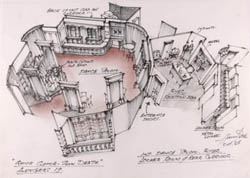isolating isometrics
Interior of Dance Studio, Foyer, Locker Room,
& Rear Corridor
1965
Chisel tipped felt pen on sketch paper
Throughout his career, Harry Pottle used isometric drawings regularly in his set design process. A number survive for The Avengers (including the design for Steed's apartment elsewhere in this exhibit). An isometric design is a three-dimensional perspective projection that shows the relationship between several sides of the same object and is particularly useful in clarifying the complexities of a composite set (i.e. a set combining more than one room or space).
One of the most striking examples of Pottle's isometric drawing is his design for the dancing school, "Terpsichorean Training Techniques," in the episode "Quick-Quick Slow Death" (1966). The key set for this episode is a composite of five separate but interconnected spaces: foyer, dance studio, locker room and a rear corridor leading to a box room which in turn has a peephole through to the studio. Much of the broad, deliberately Kitschy humor in the decoration and dressing of the dance school set is at best dimly visible in the drawing: for example, ludicrous life-size cutouts of the drunken band leader in the studio, in which he is seen playing every instrument, conceal the tape recorder which actually plays the music he is supposed to conduct. Other details were not yet devised at the time the drawing was made: best of all, perhaps, are the "footprints" painted on to the floor and walls of the reception area—all drawn from the diagrams in a dance manual [fig. 14]. The drawing is above all a practical document. The rooms are connected to one another in such a way as to allow for visual interest (none of them, be it noted, is rectangular), easy camera set-ups, and most importantly for the continuous action between spaces that reaches its acme in the climactic fight scene—one of the series' funniest.
Although as usual laced with menace, "Quick-Quick Slow Death" is primarily comic, and each main set is the site for different kinds of humor, from broad farce to satirical repartee. In addition to the dance school, "Quick-Quick Slow Death" called for scenes in a Ministry interrogation room, a tattooist's parlor, a gentleman's outfitters, a designer shoe boutique, an abandoned office building and a bank. Harry Pottle took this fragmented narrative as an opportunity to experiment and play with different possibilities. Rather than creating designs that are stylistically uniform, he strove to design sets that were unique to each vignette, making all of them memorable in their own terms. For example, the tattooist's shop is filled with engagingly human detail [fig. 15a & 15b], whereas the interrogation room is spare and almost surrealist in treatment [fig. 16a & 16b], its only real piece of furniture being an old claw-foot bathtub, and the placement of its architectural features (windows, picture rail, and so on) being subtly illogical, and therefore disconcerting.

